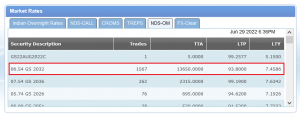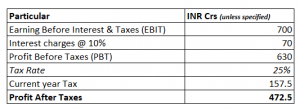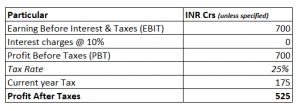16.1 – Market risk premium
In the previous chapter, we discussed that the equity holders expect a higher return than the debt holders. The higher return (rate) is what we will use to discount the free cash flow to the equity holders. But the question is, how much higher?
You can think about it this way: if the risk-free rate (Rf) is 7%, how much more would you like (over and above the risk-free rate) so that you feel encouraged to invest in equities? If you were to ask a bunch of investors and take an average of the expected return, you would arrive at the rate. However, most individual investors won’t have access to such a consensus. Hence we can probably apply an equation to get our answer.
Re = Risk free rate (Rf) + Risk premium
Where Re = Return expectation of equity holders.
The risk premium is the additional return over and above the risk-free return to encourage an investor to invest in equities. The risk premium is –
Risk premium = β*(Rm – Rf), where
Rf = Risk-free rate
Β = Beta of the stock
Rm = Market rate
Of course, we can rearrange the Re equation –
Re = Rf + β*(Rm – Rf)
By the way, this equation in finance is called ‘The Capital Asset Pricing model’ or CAPM.
Let’s take an example and see how this works. The best proxy for the risk-free rate is the 10-year-old Govt bond yield. We can look it up on the CCIL portal –
I’ve highlighted the last traded yield of the 10-year Government bond maturing in 2032. The yield is 7.4586%. The yield indicates that if I were to invest in this bond and hold it for 10 years, I would earn a return of 7.4586% without any risk. Without any risk, because we don’t expect Govt of India to default on its debt obligations, default risk is almost non-existent.
Government defaulting on debt is a severe issue, so governments try their best not to default. Also, why are we considering 10 years and not any shorter-term bond? This is because we are interested in longer-term yields as we also forecast the free cash flow for the long term.
Next up is the Beta. Beta, as you may know, is the company’s stock price sensitivity with respect to the stock market. I’ve explained the concept of Beta and what it means in this chapter. I’d suggest you review it if you are not familiar with the idea of Beta as explained in section 11.5 of this chapter.
Rm is the market rate, and this is the market’s long-term average return. I’d suggest you keep this around 8% to 9%, maybe 10 or 12%, if you are bullish.
Please note that when we build the final model, all these rates can be changed to whatever you think makes sense. Let’s assume that the Beta of the company we are dealing with is riskier compared to market, and therefore we assign the Beta as 1.3.
By the way, you can easily calculate the Beta of any company in excel. Anyway, let us plug in these numbers and see how the return expectation of equity holders works –
= 7.4586% + (1.3) *( 8.5%-7.4586%)
= 8.81%
Of course, when we integrate this within our model, you are free to change the values to what you think makes sense. For example, if you feel the risk-free rate should be 8% instead of 7.45%, that’s fine, but whenever you make any change, make sure you have a reason for that change.
16.2 – Tax shield
In the last chapter, we learned that we could get the Free cash flow to the firm by adding non-cash expenses back to the Profit after taxes. The non-cash expenses included the following –
-
- Depreciation
- Amortization
- Deferred taxes
- Proceeds from the sale of assets
- Interest expense
Adding the interest expense part is tricky, and we need to spend some time understanding how to add the interest. Let me take an arbitrary example to illustrate this, have a look at this –
As you can see, we have a fairly straightforward bottom line P&L of a company. The EBIT is 700 Crs, and the company pays 70Cr as interest charges at 10%. The PBT is 630 Crs, and at a 25% tax rate, the company pays a tax of 157.5Crs. The bottom line i.e. PAT = PAT – Taxes = 472.5 Crs.
Now, to calculate the Free cash flow to the firm, we start with PAT and add back non-cash expenses. We also add back the interest paid because the interest goes back to the debt holder of the company. If we were to do this –
PAT = 472.5
(Add) Interest = 70
= 542.5
But there is a problem doing this. You see, when we pay interest, the tax outflow reduces. For instance, the tax here is 157.5 Crs while the interest paid is 70. Now, consider the interest as 0, this would make PBT 700, and at 25% tax, the tax outflow is 175.
So in a sense, interest shields us from a higher tax outflow. So interest that we add back should be factored in for tax shield. To do that –
Interest (with tax shield) = Interest *( 1 – tax)
= 70*(1-25%)
52.5
So when you add back interest to PAT to calculate the FCFF, we add 52.5 here and not 70. In this example –
PAT = 472.5
Interest = 52.5
525
Just to refresh, for FCFF calculation –
FCFF = PAT + Depreiciation + Amortization + Interest*(1-tax rate) + deferred taxes – working capital changes – investment in fixed assets (CAPEX).
We start the FCFF calculation with PAT, but instead, we can even begin with EBIT. If we were to start with EBIT, we need to add back the tax shield.
FCFF = EBIT *(1-tax rate)+ Depreiciation + Amortization + deferred taxes – working capital changes – investment in fixed assets (CAPEX).
Let’s plug in the above equation for the arbitrary example –
= 700*(1-25%)
= 525
Of course, for the sake of simplicity, I’ve ignored the non-cash expense, CAPEX, and working capital changes. But the point is that you can start your FCFF calculation with either PAT or EBIT; both will lead you to the same result.
You can extend the calculation to figure out the free cash flow to the equity holders by deducting the net debt from the free cash flow to the firm.
Free Cash flow to Equity = FCFF + [Debt – Principal repayment]
Where, [Debt – Principal repayment] = Net debt
Hence,
Free Cash flow to Equity = FCFF + Net debt
We will get back to this later when we implement the FCFF and FCFE within our model.
Key takeaways from this chapter
-
- Equity investors expect a return over and above the risk-free rate and that is called the risk premium
- The risk premium depends on the beta of the stock. Higher the beta, higher the premium
- When the company pays interest, it gets a tax shield
- When you add back in interest, you need to factor in the tax shield as well
- You can start the calculation of Free cash flow either by PAT or by EBIT, both yield similar results






To calculate FCFF we need to start with EBIT and as you are saying we can start with both PAT and EBIT both will yield same results, how is it possible PAT is profit after factoring tax and EBIT is earning before interest and factoring tax. PAT and EBIT are different terms how both will yield same results ?
For the FCFE formula provided at end as FCFE=FCFF + Net debt.
Shouldn’t we also deduct Interest * (1-tax rate) from it ?
We have considered the tax and tax shield right effect right?
Thankyou sir for the amazing content. I have one doubt that why we are adding net debt to FCFF to get free cash flow to equity. Shouldn\’t we subtract it?
kindly help
Because that is the cash available post paying for all obligations right? That cash needs to be factored in for free cash flow.
Typo: …rather than simply Re/Rm
Hi Karthik
Would it be fair to say that Beta B is actually (Re-Rf)/(Rm-Rf) rather than simply Re/Rf.
I think we calculated Beta as per the latter formula in the hediging futures portfolio module.
Ah, not sure. Whats your rational though?
Sir,
If I have a capital gain of 2 lakh in a single year, and I again re Invest that total amount in a few other stocks,
are the gains taxable ?
and how do we pay the tax ?
Gaurav, I think its a taxable event, but please do check with your CA once.
Sir, in this formula,\’Debt – principal repayment\’, I can find debt from balance sheet(current debt + non current debt). Interest paid is finance cost in P&L statement.
Hope I\’m right in these 2 aspects
But where can I find principal repayment?
Thanks
Thats right. Principal repayment can be checked in the associated notes of debt.
Thank you for the knowledge sharing, but i have a doubt as you mentioned:-
From FCFF, we deduct interest and principal repayments to get FCFE
Free Cash flow to Equity = FCFF + [Debt – Principal repayment]
Where, [Debt – Principal repayment] = Net debt
Hence,
Free Cash flow to Equity = FCFF + Net debt
If we have to deduct the interest and principal repayments, then why to add Net Debit in the above formula, can u plz clear this doubt?
Its just that, when you deduct Debt and principal repayment, what you get is net debt i.e. Net Debt = [Debt – Principal Repayment].
So you just add that directly.
The calculation of FCFE would be FCFF-Net debt right ?
Yeah, you can consider that.
No, first of all you have to download the template from screener.in, then using the cell reference from \”data sheet\” you have to build a model. After that you can upload it and use it for any stock !!
Hi Karthik,
1) Firstly, thanks for all the help and guidance. It helped improving my knowledge a lot.
2) Secondly, I am trying to understand FCFE formula where you mentioned to deduct Net Debt from FCFF but while writing formula you are adding it in FCFF. Could you please confirm which one is correct
a) FCFE= FCFF+Net Debt
b) FCFE= FCFF-Net Debt
3) Thirdly, while going through DCF Model as well I saw a comment from Keerthan in Chapter 15 of Financial Analysis Module where he mentioned a formula and you acknowledge it as correct. I am writing the formula below for reference and here also the interest and Net Debt is getting added rather than deducting which is quite confusing for me.
FCFE=CFOA-Capex+(1-tax)*Interest+NetDebt.
4) Lastly, in your DCF model excel sheet you have subtracted the Net Debt from the Total PV for arriving at share price. Is it correct? If so, Do we need to deduct interest cost ( Interest*(1-tax rate)) also from it if interest cost is high?
1) Thank you 🙂
2) Ah, it is FCFE = FCFF + Net Debt
3) My bad, I\’ll try and fix that typo
4) I\’d suggest you keep track of the next 1 or 2 chapters in this module where I\’ll implement the DCF module on excel.
Hello Sir,
In last chapter we discussed FCFE = FCFF – (interested to be paid + principal amount ) ,
Then FCFE Should be FCFE = FCFF – DEBT right ?
Could you please clear my concern ? . I am sure , I am missing something..
Thanks in advance
Yes, but when you say debt, ensure you have interested component and the tax shield effect taken into consideration.
Hello sir, thank you so much for taking up this topic. I have a few queries.
1. When we calculate CFO using IndAS, then interest paid, interest received and dividend received is not considered to be a part of the operating activities right? However, US GAAP treats them as a part of the operating activities. Thus,
FCF=CFO-CAPEX (for US GAAP) and it would be FCF=CFO+interest and dividend received-interest paid-CAPEX (for IndAS). Is it right to say this?
2. Should dividend paid also be subtracted in the above formula?
3. FCFF=FCF+interest (with tax shield) [For both]. Will this be the correct relation between FCF and FCFF?
1) Yes thats right. But please do get another opinion as well on this topic, given that InDAS is not something I\’m familiar with
2) Yes
3) Yes, this will be.
Hello Sir
Sir can you please tell when will you upload the next chapter ?
Next week maybe, Yash.
First of all A Big Thank You to you and the Varsity team. I have one question, after finishing this financial modelling template, can we export it to Screener.in and export other Companies Financial Modelling Data in this format?
I\’m not sure about that, Prasad. Have never tried.
Karthik Sir,
First of all, I\’d like to extend my deepest gratitude to you and the Varsity team for providing us with exceptionally detailed financial courses and on top of that, making them free of cost. My question would be when will this module launch on the Varsity app and when it does, will it have a certification quiz like the equity and derivatives modules?
I\’m trying to finish the module soon. MAybe another three chapters or so. Once done, we will make this live on app as well.
thank u sir
Sure. Happy reading.
Sir What are the other topics , one need to learn other than the modules of our Varsity to get the complete view to become a Complete investor ??
For investing, I\’d suggest you go through this module and the FA module.
Sir Would you please list out the Names of the remaining modules to be covered in our Varsity
The current module will have few more chapters and will end with DCF implementation on the main model. About the other modules, I\’m not sure about it 🙂